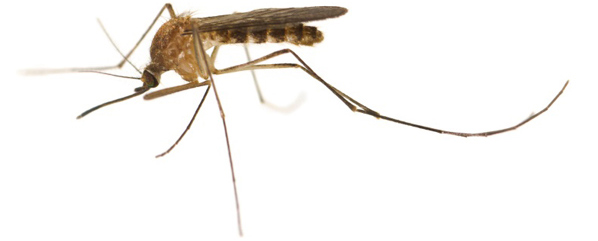Mosquitoes

Origins and distribution
Found worldwide, including temperate regions with a number of species present in the UK.
Characteristics
They are about 8 – 10 mm long and up to 20 mm wide, winged with a full vein pattern. They have well developed mouthparts with the ability to pierce the skin easily. Long legged with a narrow grey/black thorax and abdomen.
There are a number of flying biting insects that humans come in contact with such as:
- Common gnat (Culex pipiens)
- Banded mosquito (Culiseta annulata)
- Black fly (Simulium spp.)
- Biting midges (Ceratopogonidae)
Breeding
Eggs are normally laid in standing or stagnant water however some species prefer salt or brackish water. The eggs can be laid either individually or in numbers together and are known as rafts due to their boat like appearance. These hatch after a few days and the aquatic larvae emerge coming to the surface to breath. They feed on minute plants and other debris and go through a series of moults (4 – 5) over a 4 – 8 week period. Pupation takes place in the water with adults emerging a few weeks later. Males are short lived with females hibernating over the winter period.
Habits
They are mainly nocturnal, with the female of the species feeding on a blood meal. Males do not have the skin piercing mouthparts that the female has, feeding on the nectar of flowering plants and therefore are harmless. Will breed in still or stagnant water often being attracted to water butts, puddles, gutters etc. The adults regularly enter buildings seeking shelter being attracted by lights. Prefers shade as opposed to strong sunlight.
Importance
Many species bite, which causes discomfort and skin irritation. They are a major cause of disease transmission in tropical areas with the transmission of such diseases as Dengue Fever, Malaria and West Nile Virus. They are relatively harmless in the UK but do have the potential to transmit disease with the changes in climate and with reports of some of these diseases being present in other areas of Europe.
How we control Mosquitoes
Control of mosquitoes and other flying insects can be difficult, the simplest solutions is to place screens on the windows where possible. Hand held aerosols approved for domestic use are effective for a quick knockdown of adults. Mosquitoes are opportunistic breeders taking advantage of any still water, and where possible habitat management such as covering over these areas or removing potential breeding areas will assist in preventing activity. We have treated some water areas with a biological larvicide (Bacillus thuringiensis) with great effect; this is applied to the surface of the water with a compression sprayer targeting the larvae and is harmless to other aquatic species.


















